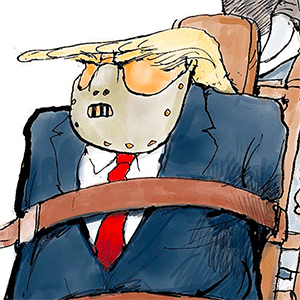Feds say New Orleans attacker acted alone, seek links to Cybertruck explosion in Las Vegas
Published in News & Features
While authorities have ruled out additional suspects in an attack in New Orleans, they are continuing to probe any possible links between the incident and the explosion of a Tesla Cybertruck outside a Trump hotel in Las Vegas.
The attacks happened within hours of each other on New Year’s Day.
Federal officials said the probe is still in the early stages and no conclusions should be reached at this time, but both suspects had backgrounds in the U.S. military and served at the same base in North Carolina.
“At this point there is no definitive link between the attack here in New Orleans and the one in Las Vegas,” Christopher Raia, deputy assistant director of the FBI’s counterterrorism division, said at a press briefing Thursday.
In New Orleans, the feds looked into whether the man who plowed into revelers on Bourbon Street, killing more than a dozen, had accomplices, but officials said they found none and that the attacker acted alone.
Investigators found two explosive devices in coolers in New Orleans’ French Quarter. Surveillance footage showed Shamsud-Din Jabbar placing the items in the area several hours before the attack, according to the FBI.
Law enforcement sources told the Los Angeles Times that the devices appeared to be homemade pipe bombs with nails. The devices did not go off.
Jabbar, 42, drove a rented pickup truck bearing a flag of the Islamic State from Houston to New Orleans on New Year’s Eve. Early on New Year’s Day, officials say he drove the truck onto a sidewalk, going around a police car that was positioned to block vehicular traffic, authorities said.
The attack killed 14 and injured 35 others, officials said. Police killed Jabbar after he got out of the truck and opened fire on officers, authorities said.
Law enforcement officials told the Times that Jabbar was wearing body armor. Investigators recovered a handgun and an AR-style rifle after the shootout, a law enforcement official said. The official was not authorized to discuss details of the investigation publicly and spoke on condition of anonymity.
Jabbar joined the Army in 2007, serving on active duty in human resources and information technology and deploying to Afghanistan from 2009 to 2010, the service said. He transferred to the Army Reserve in 2015 and left in 2020 with the rank of staff sergeant.
Raia said Thursday that the FBI discovered five videos Jabbar posted online hours before the attack, in which he stated he had joined Islamic State before this summer. In one video, Jabbar explained that he originally planned to harm his family and friends but was “concerned the news headlines would not focus on the war between the believers and the disbelievers,” Raia said.
“This was an act of terrorism,” Raia said. “It was premeditated and an evil act.”
In a video on YouTube, Jabbar said he was born in Beaumont, Texas, and worked in human resources and information technology while in the Army. He described himself as a property manager and real estate agent.
Officials are combing through data on three phones and two laptops linked to Jabbar to determine whether there are any other potential leads.
The FBI is also probing the explosion of fuel canisters and firework mortars packed into the bed of a Cybertruck outside President-elect Donald Trump’s property near the iconic Las Vegas Strip that killed the driver and left seven bystanders with minor injuries, officials said.
Las Vegas Metropolitan Police Department Sheriff Kevin McMahill said authorities believe the driver was 37-year-old Matthew Livelsberger, but he cautioned that the body of the driver was burned beyond recognition so they have not been able to positively identify him. However, authorities found military identification, credit cards and a passport with Livelsberger’s name inside the vehicle, McMahill said at a news conference.
The driver sustained a self-inflicted gunshot wound to the head before the car exploded, police said.
McMahill said the truck had been rented in Colorado. An electronic license plate reader recorded the Cybertruck arriving in Las Vegas at about 7:30 a.m. Wednesday. The truck traveled up and down the Strip for about an hour before pulling into the covered driveway outside the Trump Hotel, and exploded about 17 seconds later, McMahill said.
Law enforcement sources told the Times the vehicle was caught on surveillance camera driving past the valet section of the Trump Hotel an hour prior to the incident. Video of the explosion appear to show fireworks going off during the fire, the sources said.
Livelsberger, who was from the Colorado Springs area, was a member of the Army’s elite Green Berets special forces unit, according to an Army statement and his LinkedIn profile.
Both Livelsberger and Jabbar served at the Army’s Ft. Bragg, now known as Ft. Liberty, in North Carolina, but it is not clear whether they served at the same time or in the same unit, McMahill said.
Federal authorities said Thursday that they were still trying to determine the motive in the Las Vegas blast.
Livelsberger began working as a special forces operation manager for the U.S. Army in 2006 before switching to a remote and autonomous systems manager two months ago, according to his LinkedIn profile. He was also previously a member of the National Guard and was on leave from the military at the time of the explosion, authorities said.
On his Facebook page, Livelsberger criticized the withdrawal of U.S. forces from Afghanistan in 2021 calling it the “biggest foreign-policy failure in the history of the United States.”
“Bet Bolton got a hefty chunk from the DNC and other slimy donors to put the book out,” he wrote in a comment, referring to former U.S. national security advisor John Bolton and his memoir. When accused of being a conspiracy theorist, Livelsberger responded: “It’s not conspiracy when it’s pretty obvious guy made money from the dems.”
FBI officials in Denver wrote in a statement on X on Thursday morning that they were searching a residence in Colorado Springs in connection with the explosion in Las Vegas.
Investigators have not yet determined how the fireworks and gas and camping fuel canisters in the back of the vehicle were ignited. Two semi-automatic firearms, purchased by Livelsberger on Dec. 30, were also found inside the vehicle, McMahill said.
Investigators are looking into whether the driver deliberately targeted one of Trump’s properties using a Tesla vehicle. Elon Musk, Tesla’s chief executive, is a close advisor to the president-elect.
Federal investigators are following leads both domestically and internationally, including executing search warrants and interviewing witnesses, said Las Vegas FBI Special Agent in Charge Spencer Evans.
“There’s investigative activity taking place literally around the globe,” Evans said. “At this particular time ... we have to focus on what we know and what we don’t know. It’s not lost on us that it’s in front of the Trump building that it’s a Tesla vehicle, but we don’t have information at this point that definitively tells us or suggests it’s because of this particular ideology or any of the reasoning behind it.”
The Cybertruck involved in the Las Vegas incident and the Ford pickup truck used in the New Orleans attack were both rented through Turo, a platform where people can rent cars directly from vehicle owners.
A company spokesman said Turo is working with law enforcement, but that it does not believe that either renter “had a criminal background that would have identified them as a security threat.”
©2025 Los Angeles Times. Visit at latimes.com. Distributed by Tribune Content Agency, LLC.







Comments